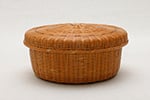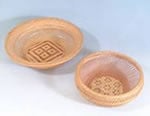History of Beppu Bamboo Crafts
The origin of Beppu bamboo crafts is said to be when Emperor Keiko stopped by Beppu on his way back from his conquering of the Kumaso tribe in Kyushu, one of his servants in charge of meals discovered an abundance of high quality bamboo and made a Mego (bamboo basket for rice bowls) using them.
It is also said that during the Muromachi period (1336-1573) , a Kijishi (craftsman who hollowed out wood and ground it with a potter’s wheel to make bowls and trays) came up with the idea of using bamboo to make salt baskets from salt vats, and then baskets for peddling began to be produced for trade.
In the Edo period (1603-1868), Beppu was known as the best hotspring resort in Japan, and people from all over the country began to come here to enjoy the splenders of these hotsprings. Bamboo kitchenware, such as rice baskets and rice strainers, which were used by bathers during their stay, were taken back to their homes as souvenirs, and many bamboo crafts were produced to supply this demand.

Rice storage container
In 1902, the Beppu Hamawaki Technical Apprentice School (predecessor of the present Oita Prefectural Technical High School) was established with the aim of fostering bamboo craftsmen for the modernization of the bamboo art. Anticipating its potential, many bamboo artisans from all over the country came to the school to acquire the superior manufacturing techniques and this built the foundation of Beppu bamboo craftsmanship, leading to the establishment of Beppu’s local industry.
Becoming more than just a souvenir, “Beppu bamboo crafts” has developed into a craft that concentrates on its advanced techniques.
In 1938, the Oita Prefectural Industrial Research Center, Beppu Craft Institute was opened to improve bamboo craft techniques, and in 1939, Oita Prefecture established the Oita Prefecture Wounded Warrior Vocational Re-education Institute (predecessor of the present Oita Bamboo Craft Training Center). Today, as the only school specializ in bamboo crafting in Japan, it continues to produce a large number of bamboo artists.
In 1950, to promote the further development of bamboo craft techniques, Beppu City established the Beppu City Craft Institute (the predecessor of the Beppu City Traditional Bamboo Crafts Center) to conduct prototype research on the bamboo craft and provide technical guidance to the producers.
Beppu bamboo craft had been growing steadily until the mid-1950s, when the Japanese economy entered a period of rapid growth, and the demand for bamboo products began to decline due to the spread of cheap plastic products.
However, the Beppu bamboo craft, with its accumulated advanced skills and ability to adapt to the changing marketplace, made a shift to high quality bamboo products, making a clear distinction from everyday household items.

Basket
As a result, a higher level of fine arts and crafts, which is separate from popular crafts, began to be developed. Many bamboo artists who not only sublimated their skills but also enhanced their formative qualities came to be produced, and among them, was SHONO Shounsai of Beppu City became the first bamboo craftsman to be designated a living national treasure in 1967.
In 1979, Beppu bamboo craftsmanship was designated as a "Traditional Craft" by the Ministry of International Trade and Industry (predecessor of the present Ministry of Economy, Trade and Industry) . In Beppu, the history of bamboo craftsmanship continues to be marked by effective use of bamboo resources and the protection and development of traditional techniques.




